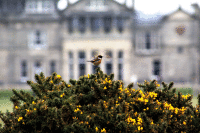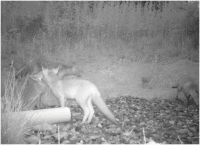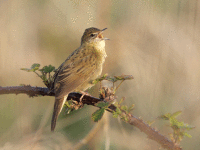The Open - It's their home too

The Open Golf Championship rolled into town in July and, with it, brought numerous articulated lorries, television towers, seating, restaurants, bars and around 200,000 spectators! All seven golf courses that make up the St Andrews Links Trust are managed to the highest standard and are well equipped enough to deal with the pressures faced by an event of this scale, but what about the wildlife? Does it stay, does it leave, or does it simply hide until the mammoth crowds have subsided? I have written this article to give you a brief insight into how the Trust's flora and fauna deals with one of golf's biggest competitions.

Firstly however, what type and how much wildlife lives on the Links? With approximately 1000 acres of land, you would have thought that St Andrews golf courses are teaming with life, and you'd be correct! At the last count, there were eighty-seven different types of birds, ten butterfly types (not bad considering it is windy for the majority of the time) and, from March up until writing this article, there were 120 types of wildflower showing. Fungi feature prominently, but we have not got around to identifying them as of yet!
In terms of rabbits and hares, I have to say that there was a significant drop in both of these. I'm positive that they simply moved over to the New, Jubilee or Eden courses where there was a little more privacy and room to run. No stoats or weasels were reported, but there was some great news to report on with the slightly larger mammals; our resident fox has had a litter of cubs! The on-course infra-red wildlife camera has been catching some marvellous snaps of the female and her three cubs. We have been helping her out by placing a few small bits of scrap food close to the camera - we need her and the family to catch a few rabbits for us, but this practice is only undertaken occasionally.

There was a small issue affecting the heather last autumn and that was an outbreak of the heather beetle. This annoying insect's larvae, when in large groups, are capable of stripping a mature heather plant to a state where it can no longer recover. The area which was previously dominated by heather reverts back to grassland in no time at all, so it was imperative that we managed the infested area as soon as possible.

We chose to manage the area holistically rather than using chemicals, so a team of greenkeepers spent a good few afternoons manually stripping away the thatch from beneath the affected heather plants. The thatch layer is where the heather beetle overwinters so, by undertaking this task, we removed the problem at its source. I am pleased to say that this operation worked a treat and the damaged heather plants seem to be recovering nicely!
The wading birds including curlews, oystercatchers and lapwings were noted on the New and Jubilee Courses when the tide was high, with many being seen on the ninth and tenth of the Old Course too. However, the denizen grasshopper warbler did not like all the fuss and made a swift exit over to the main composting station where it remains to this day - it is very difficult to see, but its impersonation of a grasshopper is quite endearing to hear and, if you try and position yourself within earshot of this beautiful bird, then you may be lucky enough to see it darting through the undergrowth.
The grasshopper warbler's departure was in stark contrast to the other similar sized birds on the Links - linnets, house sparrows, stonechats, reed warblers and yellowhammers were not perturbed by the giant crowds and remained throughout the tournament. The well managed gorse and trees (yes the Old Course has trees!) offered lots of hiding places when things got lively, so they simply hid away until the crowds subsided.

As the weeks passed, we observed the nest from a distance and it was plain to see that the chicks were doing well by the amount of times their parents came backwards and forwards with food in their beaks.
During the run-up to the Open, however, it was obvious that the roped off nest area needed to be far larger as both parents were becoming more and more agitated by the amount of foot traffic past their offsprings' nest site; they were also finding it difficult to feed the chicks as the sheer amount of spectators made it almost impossible to make it to the nest without being spotted and subsequently photographed! It was therefore decided that the footpath adjacent to the rear of the tee should now be used for emergencies only and the roped off area was now stretched to about the 70m² mark.

The championship tee was monitored by five marshals throughout the tournament and each one was briefed that no one was allowed into the area where the nest was located. Signs were made indicating that there are ground nesting birds present and a security guard made sure that the nest was protected at dusk.
On the Sunday of the Open, I was informed by the marshals that they had to escort a very small and scruffy looking chick off the championship tee and place it back into the long grass from where it came. I managed to catch a glimpse of two chicks early Monday morning (the final day of the championship) and I could hear another one chirping away in the gorse behind the tee. If three chicks made it, then I think you could describe the operation as a success - I like to think all four will make it to adulthood, but nature can be cruel sometimes and not all young birds reach maturity.
Another interesting event happened during the approach of the Open and that was a pair of oystercatchers had made a nest on the roof of the Tom Morris building. This building is a hive of activity most days and it is where we house our range of clothing; it also has a succulent roof which attracts a diverse cross section of wildlife, including bees, butterflies and many other invertebrates, but the oystercatchers made it their home for around four weeks - I have to say that they were most welcome and we hope to see them back next year, or sooner!

The Operation Pollinator sections hold a healthy amount of maiden pinks and there's a Corncockle growing peacefully on the Eden Course, so the flora remained intact throughout the competition. I feel that the only flora damaged by the competition was the actual grass on the walkways, but the Old Course team are amongst the finest, so they will have these back in top condition by the time the Dunhill rolls in to town.
It is safe to say that a competition of the Open's magnitude is going to bring with it one or two victims in terms of organic materials, i.e. the flora onsite, however, it is also safe to say that the remaining wildlife benefitted from the competition, meaning that the majority of animals had a buffet of food from all the scraps which were dropped throughout the day. Gulls, rooks and crows made the most of the tournament by hoovering up any chips and pasties which found their way onto the floor, whilst the foxes took the rest!
All the stands and scoreboards had material placed around them so no swallows or house martins could build a nest beneath the eaves, whilst the marshals took great pride in keeping any foot traffic away from the long rough and roped off areas.
The greenkeeping team worked wonders on the golf course and it is fair to say that the Home of Golf and the Open Championship take the on-course wildlife and its subsequent protection quite seriously! Roll on the Dunhill Links Championship!
